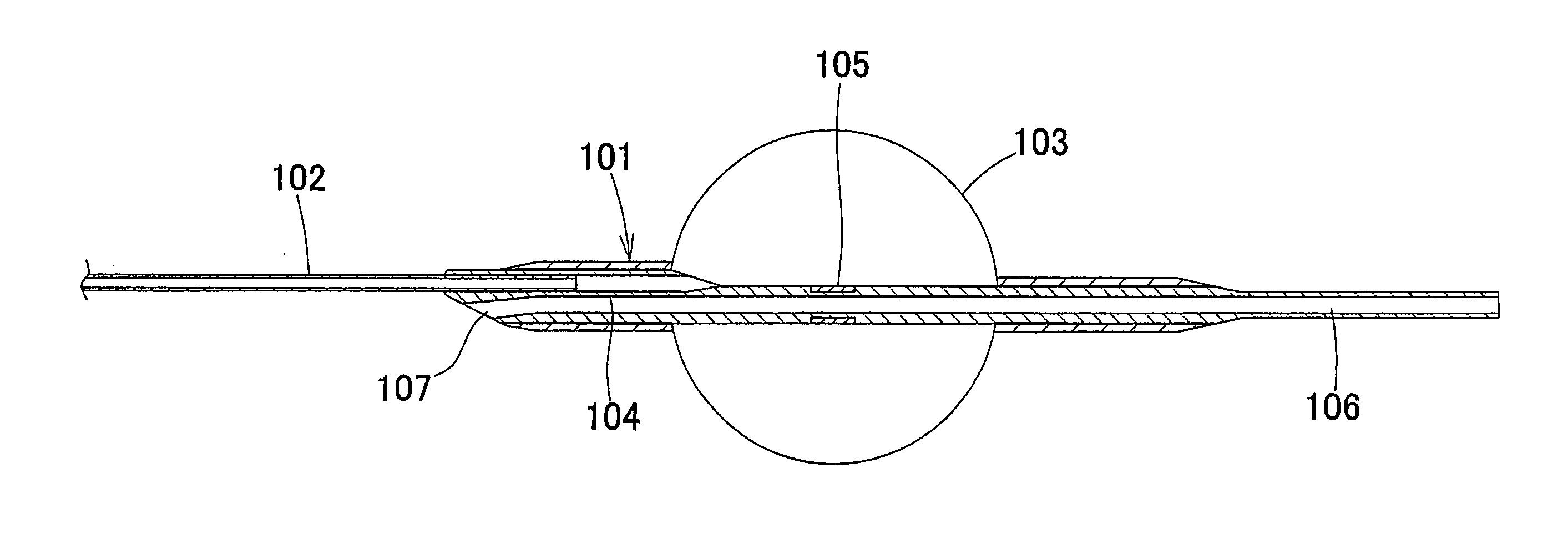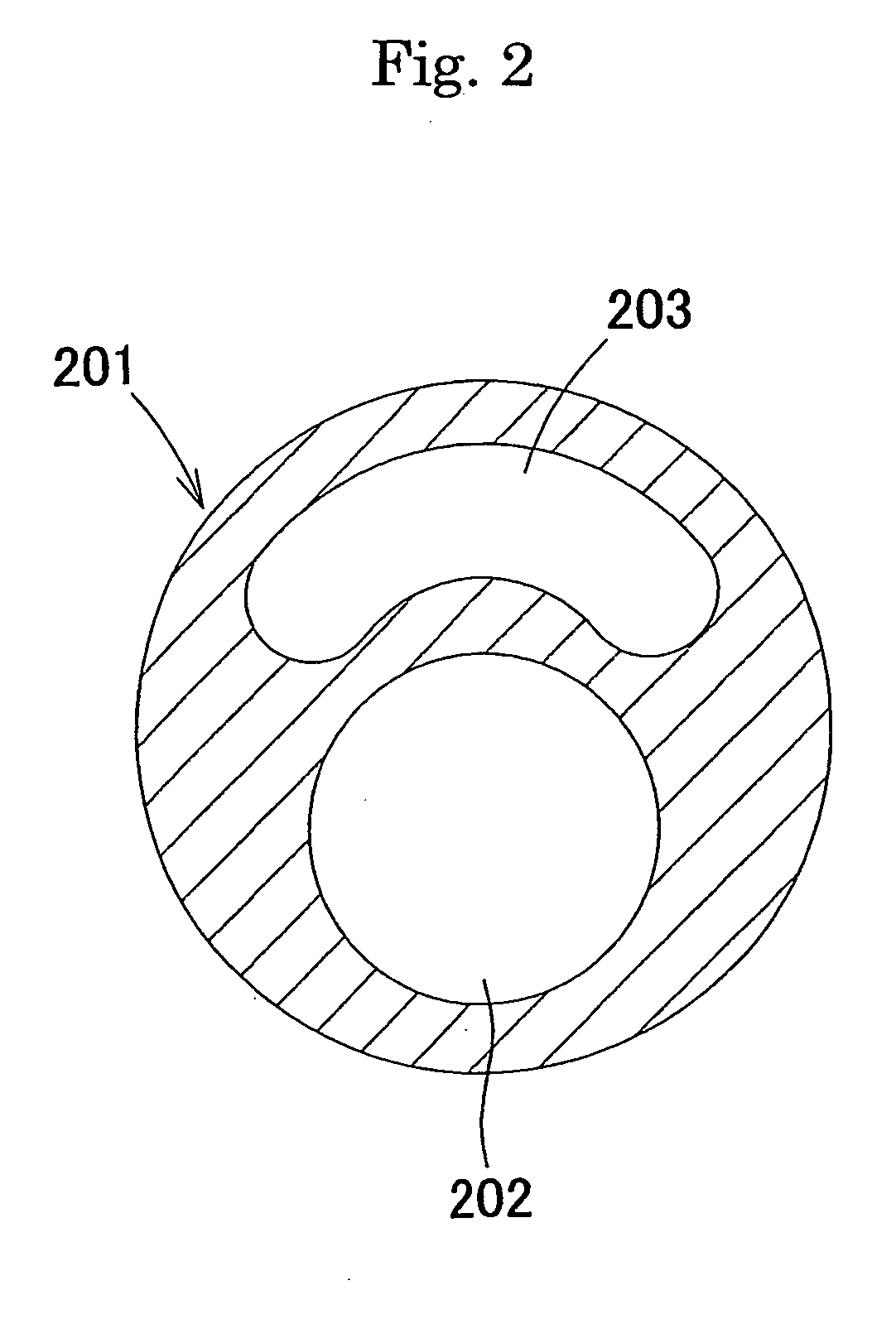Balloon catheter for tentative vaso-occlusion
a balloon catheter and vaso-occlusion technology, applied in balloon catheters, surgery, angiography, etc., can solve the problems of slow flow or no flow phenomenon, occlusion of downstream peripheral blood vessels, and recovery time, and achieve the effect of superior maneuverability
- Summary
- Abstract
- Description
- Claims
- Application Information
AI Technical Summary
Benefits of technology
Problems solved by technology
Method used
Image
Examples
example 2
[0049] FIG. 3 shows another example of the present invention. The structure of a catheter 301 is basically the same as in EXAMPLE 1. In FIG. 3, reference numeral 302 denotes a shaft, 303 denotes a balloon, 304 denotes a base shaft, 305 denotes a radiopaque marker, 306 denotes a guidewire lumen, and 307 denotes a guidewire port. The difference from EXAMPLE 1 lies in that the balloon was composed of thermoplastic polyurethane Tecoflex EG85A manufactured by Thermedics, that methylene chloride was used as the solvent, and that a high-density polyethylene thin tube was used as the guidewire lumen tube for making the guidewire lumen. The guidewire lumen tube had a 1-mm projected portion at the guidewire port portion and this portion was crushed. FIG. 4 is a diagram viewed from the A-A cross-section of FIG. 3 in the direction toward the catheter distal end. In FIG. 4, reference numeral 401 denotes a base shaft, 402 denotes a shaft cross-section, 403 denotes a guidewire port, and 404 denote...
example 3
[0050] In EXAMPLE 3, the guidewire lumen for tracking the guidewire was formed at the distal-end side of the balloon. FIG. 5 shows the structure of this example. A shaft 502 of a catheter 501 was a metal tube composed of SUS 304 stainless steel having the same dimensions as in EXAMPLE 1. A SUS 304 stainless steel core wire 508 having a proximal-side outer diameter of 0.2 mm and a length of 18 mm was disposed at the distal-end portion of the shaft 502. The reason for providing this core wire 508 is to gradually change the stiffness from the shaft 502 to the catheter distal-end portion so that a guidewire lumen 506 is formed at the distal-end portion of the shaft 502. The core wire 508 may be tapered so that the wire becomes gradually thinner toward the distal end. In this manner, the stiffness of the catheter distal-end portion can gradually decrease. In this example, the core wire 508 was adjusted so that the outer diameter at the most distal end was 0.15 mm. Although YAG laser proc...
example 4
[0051] FIG. 6 shows another example of the present invention. The structure of a catheter 601 is basically the same as in EXAMPLE 1. The difference from EXAMPLE 1 lies in that a shaft 602 is constituted from a distal-end shaft 607 composed of a NiTi alloy, i.e., a superelastic metal, and a proximal-end shaft 609 composed of SUS 316 stainless steel. The superelastic metal tube (the distal-end shaft 607) had a length of 400 mm, an outer diameter of 0.35 mm, and an inner diameter of 0.28 mm. The distal-end shaft 607 was bonded to the proximal-end shaft 609 via an extension tube 608 using a two-part urethane adhesive, as shown in FIG. 6. The extension tube 608 had a length of 20 mm, an outer diameter of 0.25 mm, and an inner diameter of 0.18 mm and was composed of SUS 316 stainless steel. In bonding the extension tube 608 to these shafts, appropriate care must be taken to prevent the adhesive from flowing into the lumens of the shafts. In order to avoid the formation of a step differenc...
PUM
 Login to View More
Login to View More Abstract
Description
Claims
Application Information
 Login to View More
Login to View More - R&D
- Intellectual Property
- Life Sciences
- Materials
- Tech Scout
- Unparalleled Data Quality
- Higher Quality Content
- 60% Fewer Hallucinations
Browse by: Latest US Patents, China's latest patents, Technical Efficacy Thesaurus, Application Domain, Technology Topic, Popular Technical Reports.
© 2025 PatSnap. All rights reserved.Legal|Privacy policy|Modern Slavery Act Transparency Statement|Sitemap|About US| Contact US: help@patsnap.com



